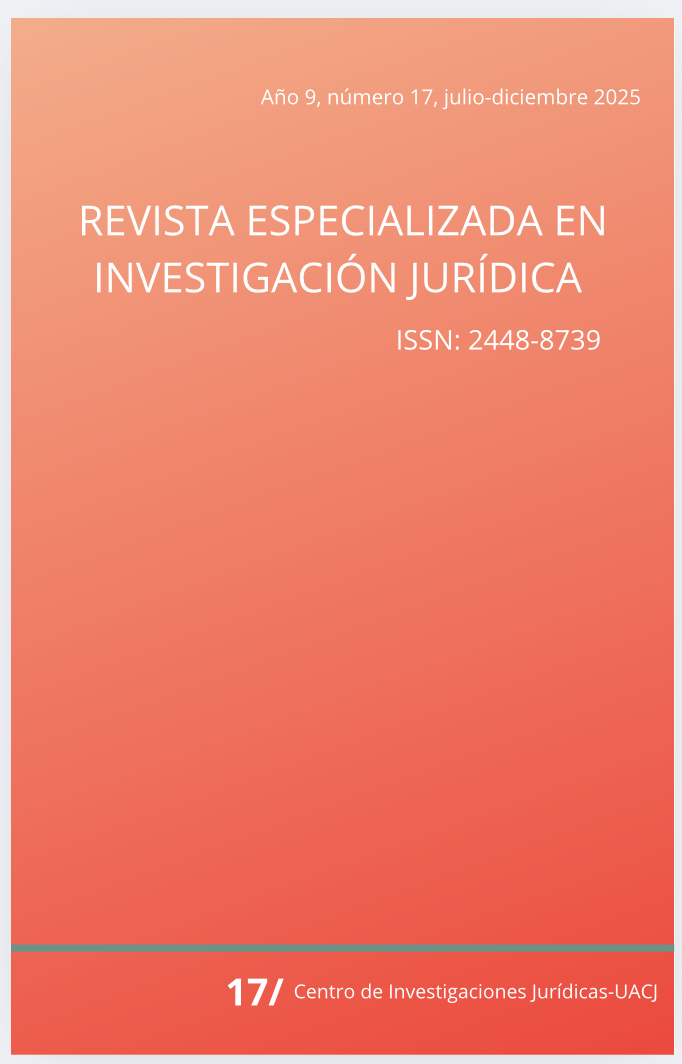Conceptual and methodological foundations for designing and developing the state of the art in legal research
DOI:
https://doi.org/10.20983/reij.2025.2.2Keywords:
legal bibliometry, legal research, literature review, research methodology, state of the artAbstract
This article analyzes and examines the conceptual and methodological foundations to design and develop the state of the art in legal research with a methodological approach that promotes a deep understanding of the plurality of approaches within this discipline, highlighting its importance for the identification of trends, gaps and doctrinal debates. First, the review of bibliographic sources is addressed with emphasis on the relevance of using current and reference documents to guarantee the theoretical and practical solidity of the research. Likewise, the validity and relevance of the sources is analyzed in a constantly evolving legal context, highlighting the need to adapt the theoretical framework to regulatory and jurisprudential changes. Regarding the methodology, a structured formulation is proposed for the design of the state of the art, which includes the identification, classification and critical analysis of primary and secondary sources. This approach allows us to articulate a solid conceptual framework that guides contemporary legal research. Finally, the main reference sources on legal methodology are explored, contributing to a debate on the plurality of approaches in scientific legal research.
Downloads
References
Arias, F. (2017). Obsolescencia de las referencias citadas: un mito académico persistente en la investigación universitaria venezolana. Revista e-Ciencias de la Información, 7(1), 1-13. doi: http://dx.doi.org/10.15517/eci.v7i1.26075
Botero, A. (2016). Sobre el uso de la bibliografía en la investigación jurídica. Revista Pensamiento Jurídico, 43, 475-504. https://revistas.unal.edu.co/index.php/peju/article/view/60774
Cifuentes, M. R., Osorio, F. y Morales, M. I. (1993). Una perspectiva hermenéutica para la construcción de estados del arte. Cuadernillos de Trabajo Social. Universidad de Caldas.
Codina, L. (2020). Cómo hacer revisiones bibliográficas tradicionales o sistemáticas utilizando bases de datos académicas. Revista orl, 11, 139-153. https://revistas.usal.es/cinco/index.php/2444-7986/article/view/orl.22977
De Solla-Price, D. J. (1963). Little Science, Big Science. Columbia University Press.
Galeano Marín, M. E. y Vélez Restrepo, O. L. (2002). Estado del arte sobre fuentes documentales en investigación cualitativa. Universidad de Antioquia, Centro de Investigaciones Sociales y Humanas.
Guevara Patiño, R. (2016). El estado del arte en la investigación: ¿análisis de los conocimientos acumulados o indagación por nuevos sentidos? Revista Folios, 44, 165-179.
Jiménez, A. (2004). El estado del arte en la investigación en las Ciencias Sociales. Universidad Pedagógica Nacional.
Pérez Carrillo, J. R. (2024). La pluralidad metodológica de la investigación jurídica y la orientación dimensional de sus tipologías. nullius: Revista de Pensamiento Crítico en el Ámbito del Derecho, 5(2), octubre 2024) 38-52. doi: https://doi.org/10.33936/revistaderechos.v5i2.6909
Uribe, J. (2005). La investigación documental y el estado del arte como estrategias de investigación en Ciencias Sociales en la investigación en Ciencias Sociales. Estrategias de investigación. Ediciones Universidad Piloto de Colombia.
Valdés, R., Fernández, O. y Da Silva, J. (2005). Las investigaciones sobre formación de profesores en América Latina: un análisis de los estudios del estado del arte (1985-2003). uniube. www.uniube.br/propep/mestrado/revista/
Vargas, G. y Calvo, G. (1987). Seis modelos alternativos de investigación documental para el desarrollo de la práctica universitaria en educación. Educación Superior y Desarrollo, 5.
Downloads
Published
Issue
Section
License
Copyright (c) 2025 Juan Ramón Pérez Carrillo

This work is licensed under a Creative Commons Attribution-NonCommercial-ShareAlike 4.0 International License.
El titular de los derechos de explotación de los contenidos de la Revista Especializada en Investigación Jurídica es el Autor o Autora
El licenciamiento bajo el cual se publican los contenidos es Atribución-NoComercial-CompartirIgual 4.0 Internacional (CC BY-NC-SA 4.0) por lo que se autoriza compartir, copiar y redistribuir el material en cualquier medio y formato, adaptar, remezclar, transformar y construir a partir del material para cualquier propósito, siempre y cuando no sea con fines comerciales y se cite al autor(es) original y a la fuente, proporcione la liga a la licencia Creative Commons e indique claramente si se hicieron cambios a la obra y especifique cuales fueron dichos cambios. Para más información consultar el apartado de Política de Acceso Abierto de la revista.

















